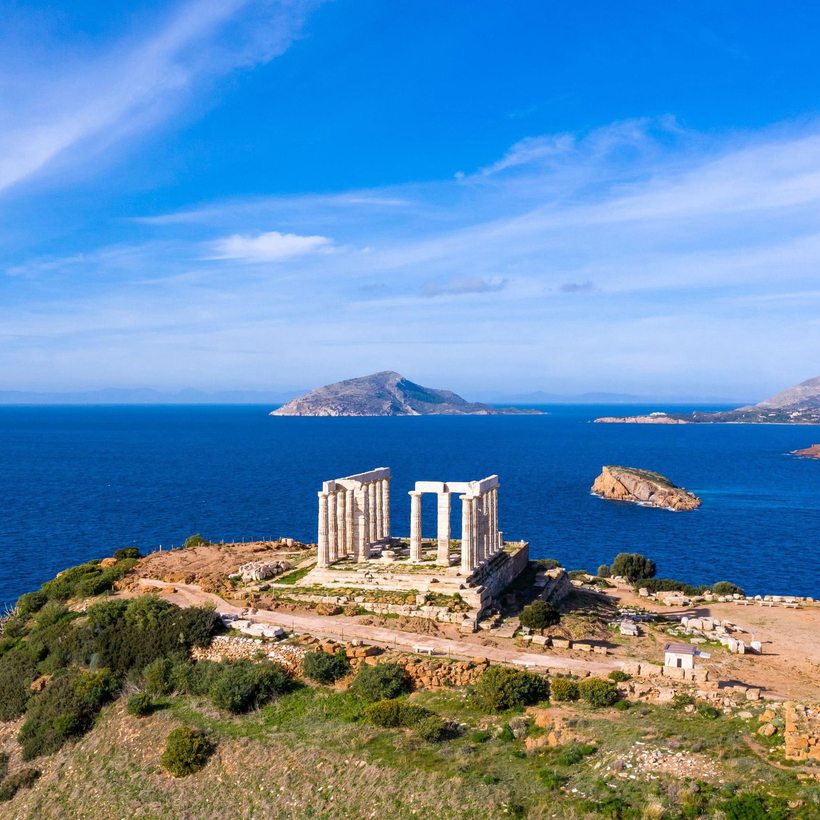The Athenian Riviera, the 40-mile stretch of coastline that runs south from Athens to Cape Sounion along the Saronic Gulf, has long been a sotto voce favorite of the Greek beau monde.
They especially love spending time there in June and July before decamping to the islands for the rest of the summer. It’s also a perfect base for visiting Athens from March to October, combining a cultural experience with a proper let-the-screen-go-blank Aegean vacation of swimming, reading, eating, and boating.
I know all of this thanks to George, whom I met in my sophomore English Composition class at Amherst College. Back then, he wore a different cashmere sweater every day, from a pea-green cable-knit to a double-ply ivory V-neck. Envious, I struck up a conversation.

“Do you buy them at Filene’s Basement?,” I wondered. “No, they’re from Harrods. My mother sends them to me,” he replied. I soon learned that George was from Athens, where his very wealthy father ran a shipping company, and, although our lives were quite different, we became friends based on a mutual affection for books, tennis, and good food.
When I was studying in London, during my junior year, I spent the Christmas holidays traveling around Europe on an Interrail pass. I called George when I arrived in Athens, but he had already left for Gstaad. “Join us! Take our plane,” he insisted, but I had neither skis nor money, so I told him I would stay in Greece.
“Athens is not very nice in the winter,” he warned. “Go to the museums and then get out of the city—take the bus to see the Temple of Poseidon at Sounion, then have lunch at our favorite fish restaurant. Promise me you’ll go, Alec. You will be our guest.” In those days—the late 70s—people actually arranged things like this.

Built from 444 to 440 B.C., the Temple of Poseidon is still one of the most magnificent places I’ve ever seen. The temple itself is a handsome classical monument that’s been meticulously restored by various archaeologists, but what brings it to life are the sweeping views over the Saronic Gulf and the Aegean Sea. Thrilled to finally see some sunshine, I lay on a hillside for several hours before hiking to lunch.
Although I arrived at an elegant restaurant overlooking the sea—which has sadly since closed—in my Interrail finery of ski jackets, scruffy jeans, and hiking boots, I was still received like royalty. To my astonishment, another Greek-born Amherst student, named George Papandreou, stopped by my table. (He’s one of the three recent Greek prime ministers who attended Amherst.)

After a miniature banquet of salads and spreads, we ate rock-lobster pasta and grilled sargo with several bottles of excellent white wine from Santorini. Because I was woefully accustomed to the grisly fare of the budget restaurants recommended in Let’s Go: Europe, this was the best meal I had eaten since leaving London.
I returned to the Athenian Riviera nine years later, in 1988, for George’s wedding. Even then, I noticed that some of the beautiful old villas overlooking the sea in Glyfada were being torn down and replaced with high-rise apartment buildings, a sign of Greece’s growing prosperity. I stayed at one of the charming bungalows George’s family had booked at the Astir Palace, which immediately became one of my favorite hotels.

Like many others, though, I eventually succumbed to the lure of the Greek islands, spending many summers on Antiparos and visiting other specks in the Med, such as Ermoupoli and Patmos.
I hadn’t been back to the Athenian Riviera for years until a friend from New York suggested we meet for a few days in May back at the Astir Palace, which is now owned by Four Seasons Hotels and Resorts. The Canadian hotel group completely renovated the property, making it into one of Europe’s best seaside hotels. Beautifully landscaped with palms, parasol pines, oleander, rosemary, lavender, and myrtle, it occupies a walled 75-acre park overlooking the Saronic Gulf just outside of Voula.

As I drove there, I marveled at the construction boom in and around Glyfada. The Ellinikon, Athens’s former airport, has become a large seaside development three times the size of Monaco. Work is well underway on the Riviera Tower, the Foster + Partners–designed skyscraper that will be the tallest building in Greece when it’s completed. A new One&Only resort has opened nearby. Clearly, the Athenian Riviera is no longer a sleeping beauty.
But beyond Voula, almost nothing has changed. Once again, George was out of town, but he suggested we travel to Hydra, Aegina, and Moni for the day and visit one of his favorite places, the Holy Monastery of Saint Paul the Apostle, which is located on a hillside farm outside of Lavrion.

When we rang the bell at the gate, a smiling nun cheerfully showed us the chapel, with its Byzantine icons painted on the ceiling. Over almond cookies and mint-infused water, she told us about how she’d found her vocation. I was moved both by her sweetness and the monastery’s profound feeling of peace.
Before we returned to Athens, we made one last stop: the Temple of Poseidon. Nearly 40 years after I’d visited it for the first time, it was just as majestic as I remembered. And well worth driving past the skyscrapers to get there.
Alexander Lobrano is a Writer at Large at AIR MAIL. His latest book is the gastronomic coming-of-age story My Place at the Table: A Recipe for a Delicious Life in Paris


